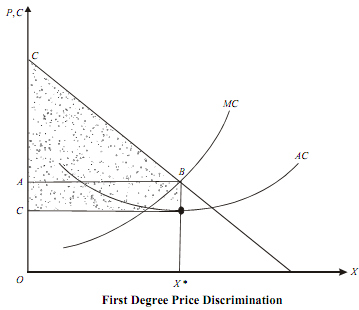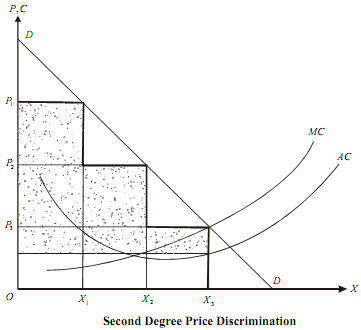Different Types of Price Discrimination:
Three types of price discrimination may be distinguished. They are personal, local and according to use. Price discrimination is said to be personal when different prices are charged to different persons. For example, a surgeon many charge different amounts for the same operation from different patients.
Price discrimination is local when the seller charges different prices for the product from the people of different localities.
Discrimination is according to use when different prices are charged for different uses for a commodity. Rates of electricity and telephone are different for commercial and domestic purposes.
Apart from these three types of price discrimination, A.C. Pigou (The Economics of Welfare, 1920) thought of some other kinds of price discrimination. He identified three degrees of discriminating power leading to three types of price discrimination.

i) First degree price discrimination or perfect price discrimination is said to occur when the seller charges a different price for each unit of output. This involves charging different prices to different consumers as well as charging different prices for different units sold to the same consumer.
The maximum price that someone is willing to pay for a unit of output is called the 'reservation price'. The perfectly discriminating monopolist charges the reservation price for each unit of output. Thus, the MR curve for the monopolist becomes the demand curve itself. In this case, the equal level of output which is given by the intersection of the demand curve and the MC curve, is the same as the output under perfect competition. This is shown in Figure.
The monopolist produces output OX* and its revenue is given by the area OX* BA. Since the monopolist charges a different price (the maximum possible price or the 'reservation price') for each unit, there is no unique equilibrium price. The dotted area represents the monopolist's profit.Thus, in first degree price discrimination the monopolist extracts the whole consumer surplus. First degree price discrimination is difficult to implement in practice. It can be used only for services for which no resale is possible.

ii) Second degree price discrimination occurs when the monopolist is able to charge several different prices for different ranges or groups of output. For example, in Figure, each of first X1 units of output are sold at a price of P1. Units between X1 and X2 are sold at price P2 and so on. Each additional unit sold from 1 through X1 adds P1 to the revenues. Similarly, each additional units sold between X1 and X2 adds P2 to revenues and so on. Thus, the MR curve is a step function shown by the thick line. The monopolist equates MR and MC to maximizing profit, which is given by the intersection of the MC and MR curves. The monopolist produces X3 units of output and the dotted area represents monopolist's profit.
iii) Third degree price discrimination occurs when the monopolist partitions the market demand into two or more groups of customers and then charges different prices to the different groups (the price is same for different persons within a group). What the monopolist is trying to exploit is the different price elasticities of demand for the different groups. Third degree price discrimination is possible only when the separate customer groups have different elasticities of demand.